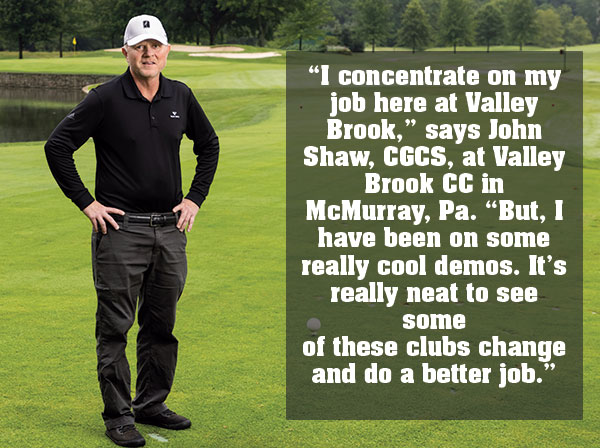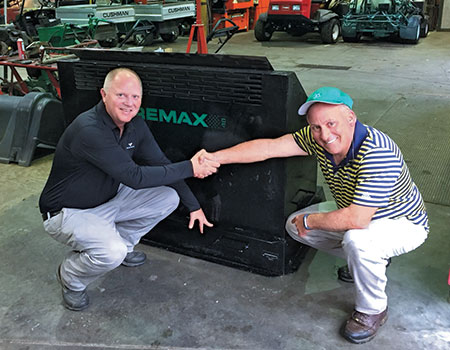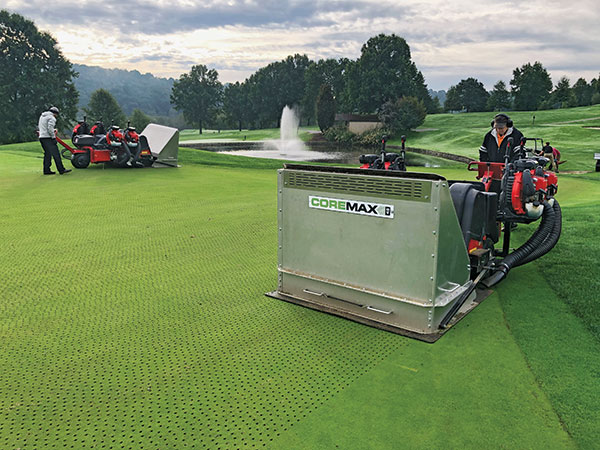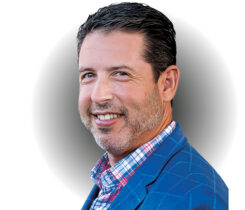2021 Herb Graffis Businessperson of the Year: John Shaw

John Shaw (Photo by: Scott Galvin Photography)
The Herb Graffis Businessperson of the Year Award, given annually since 2012, is named in honor of Golfdom’s founder, World Golf Hall of Fame member Herb Graffis. Graffis was one of the first people to think of golf as a business when he and his brother Joe founded Golfdom in 1927. With his vision, Graffis helped advance the game in numerous ways, from founding the National Golf Foundation and the Club Managers Association of America to his work advocating on behalf of superintendents and elevating their profile. It is with all due respect that we present this award in Mr. Graffis’ honor.
Alan Easter’s mind goes back to a day he’d rather not relive — and certainly will never forget. It was the longtime superintendent’s first day hosting a professional tournament. Pro-Am day …
… and there’s a massive irrigation break on the first hole.
“I isolated it. We’ve got blast-furnace winds. I thought, ‘how am I going to fix this?’” Easter recalls. “Then one of the four radios I have on me goes off and says, ‘someone has shovels on the first hole.’”
Easter doesn’t know who made the phone call, but John Shaw, CGCS at nearby Valley Brook CC in McMurray, Pa., arrived on the scene with his irrigation technician and dug up and fixed the break before the first group teed off. “John and I didn’t even talk much back then, but how can you ever forget that?” Easter says. “I get emotional thinking about it.”
Shaw is a cutting-edge superintendent who maintains Valley Brook CC to exceptional conditions. He’s also a superintendent willing to go out of his way to help his fellow super, like he did that day with Easter. And, he’s a superintendent with a mind for problem-solving who wants to help superintendents everywhere. For all these reasons, Shaw is Golfdom’s 2021 Herb Graffis Businessperson of the Year.
Money back, and then some
A 1972 Volkswagon Bug and a passion for the game of golf led John Shaw to become a superintendent. He loved playing golf, and at age 16, he had wheels and a driver’s license. Since he could drive himself to Castle Hills GC in his hometown of New Castle, Pa., he did something not many 16-year-olds would do: He bought a membership.
“I was about a month into that membership when the golf course superintendent came walking up to me on the first tee. He said, ‘Hey, I see you playing here a lot. And I already know you bought a membership,’” Shaw recalls. “He said, ‘I’m looking for somebody to work with me, and I’ll give you your money back on your membership, and you get to play for free.’ I kid you not, that’s how it all started.”
When college came around, Shaw studied engineering. Not because he liked it, but that’s what his buddies were studying. After earning a degree in mechanical engineering, Shaw immediately switched over to the two-year Penn State turf program.
While enrolled at PSU, Shaw worked at Gospel Hills GC in Erie, Pa. After graduating, he immediately became a very young superintendent at Del Mar GC in Ellwood City, Pa. He left that job to become assistant superintendent at Valley Brook and work under the tutelage of Ron Fox, CGCS, who would become his mentor.
“I knew that if I wanted to make it big in the country club business, I had to be an assistant,” Shaw says. “So, I made that name and worked for Ron for six years.”
After Valley Brook, he again became a superintendent at Duquesne GC, then at Rolling Hills CC, both in Pittsburgh. After eight years away, he returned to Valley Brook, now as the superintendent, a position he’s held since 2003. Valley Brook is 27 holes, a high-end club 20 minutes away from downtown Pittsburgh.

“I saw prototype after prototype and I was hard on him,” says Alan Easter (right) pictured with Shaw. “Never in my wildest dreams did I think I’d have something to do with this.” (Photo courtesy of Alan Easter)
Those who have known Shaw over the years describe him as “cerebral” and talk about how he always strives to find a better way. Maybe it’s that engineering background that has him constantly running tests and experimenting to observe results. When a nematode problem struck Pittsburgh in 2010, Shaw invested his own money into equipment to better analyze what was going on in his soil and shared that information with other area supers.
“Shaw has two microscopes in his office, connected to a 32-inch flatscreen on the wall. Superintendents will call me and say, ‘I think I have summer patch.’ I say, ‘you know what I’d do? I’d call Shaw. He’ll sit in his office with you for 10 minutes and tell you exactly what it is,’” says John Ferruchie, a former superintendent who now works as a consultant. “I’ve known Johnny a long, long time. I look at him as an engineer who is unbelievable at growing and managing both turfgrass and people.”
The hole problem
One common superintendent problem that had long vexed Shaw was the cores left behind by aerification, as well as the challenges weather can inflict on the process.
“My employees will be the first ones to tell you I was never satisfied with aerification,” Shaw says. “We never aerified the same way from spring to fall, fall to spring. I was always changing and trying to improve, trying to do a better job, and I started thinking, ‘there’s got to be a better way.’”
Easter adds, “You get two days in the spring and two days in the fall to get your agronomic impacts implemented. If it rains, they slap you on the back and say too bad, God intervened. And in Pittsburgh, their expectations are for 14 (feet) on the Stimpmeter every day, or you’re in trouble. John and I were talking, he said, ‘I am going to make something that will collect cores in the rain and not touch the turf’ … I said, ‘people have been trying to do that for 30 years … that’s a pipe dream.’”
Shaw’s goal: a machine that could attach to an aerifier to collect cores — before touching the greens — and be used long enough that large greens could be aerated with a complete pass without having to stop to empty the core collector. Though the sight of a crew with shovels scooping cores hurts even a member’s back, it wasn’t a matter of saving labor to Shaw, though it ended up being a huge labor saver. It was a matter of pulling a perfect core and leaving a perfect aerification hole.
“When you see a lot of layers (in a green’s soil profile), supers call that raccooning or layering. That impedes water movement, and naturally, that impedes air movement,” Ferruchie says. “The light layer is sand, the dark layer is organic matter. You go to pick up the cores with a core harvester or people pushing shovels … you leave a very fine level of organic matter. John wanted to eliminate that layer.”

“If something didn’t work out he’d tear it apart and reconfigure it,” says John Ferruchie. “He kept playing with it until he got it right. And when he got it right, it was unbelievable.” (Photo courtesy of John Shaw)
Shaw brushed off his mechanical engineering degree and went to the drawing board seven years ago. He used the nursery green as a testing ground. As the machine evolved, he used it at other area courses, gathering information along the way.
“I had many failures before I had successes, and I’m talking years of failures,” Shaw says. “About five years ago, I started getting confident, and I started the patent process four years ago. I was not willing to go to market until we had something rock-solid.”
Going into business
That machine today is known as the CoreMax 48. Two backpack blowers blow cores from the outside to the middle of the aerifier. Two more blowers attach to the manifold system and blow air straight back. After the core is ejected from the ground, it lands on a mat and is then pushed to the back of the box holding the cores.
The first course to ever buy the machine was, ironically, Alan Easter’s. Shaw, wanting to remain a superintendent, formed an agreement with SynaTek Solutions to market and sell the machine. After many conversations Easter, 57, and ready for something not as strenuous as growing grass, joined SynaTek and is now the marketing manager for the machine, giving demos around the country.
“It’s been a privilege to see this grow,” Easter says. “We’re very close to kicking the doors down. If I spent full time on this machine, I think our production would have difficulty keeping up.”
Ferruchie marvels at the machine and, like only a superintendent could do, goes on about the beauty of a perfectly punched hole in the ground.
“The hole it leaves is absolutely perfect. The mat that the cores lay on and get blown into the box serves as the absolute perfect turf hold-down,” Ferruchie says. “I said to John, ‘once you get this piece of equipment into certain markets, it will explode.’ We’re in Pittsburgh, man. We’ve got a few clubs that got some money, but we’re not Long Island, OK? We’re not Northern Jersey, you got me? Once one or two of those guys in those corridors get this piece of equipment in their hands and their buddies start seeing it, and their members see their greens were aerified and they’re absolutely perfect? Game over. They’ll sell on their own. And that’s where we are.”
Helping an industry
Shaw thinks back to the time he spent in engineering school with his buddies. He never worked in that industry, he says, but he’s built a couple neat machines over the years. He’s more excited about how he’s been able to succeed at Valley Brook for the last 18 years, and the course is something he and his mentor Ron Fox can be proud of.
“Fortunately, it’s all worked out for me. I have a U.S. patent now on the CoreMax 48. That’s when I partnered up with SynaTek. I’m letting Alan and SynaTek run with it; that way, I can continue to be a superintendent, which is what I want to do,” he says. “I’m just in love with the industry. I always have been, and I still want to be a golf course superintendent. Honestly, I’m not really interested in selling the CoreMax 48. What I want to do is help people in the industry.”
Help people in the industry. That statement harkens back to that moment on Easter’s No. 1 fairway on Pro-Am day — who could have guessed that years later, they’d have this connection?
“The CoreMax 48 is awesome, and that’s my way of giving back to the industry,” Shaw says. “It’s just not something I want to do (full time). I still want to paint this golf course and paint my picture.”











